What Do Painted Lady Butterfly Caterpillars Look Like?
Painted Lady butterfly caterpillars exhibit a cylindrical, segmented body ranging from 1.25 to 1.75 inches in length. They are characterized by distinctive black, yellow, and green longitudinal stripes that provide camouflage.
The caterpillars possess bristle-like setae and spiky black hairs that act as a defense mechanism. Their head capsules are robust, equipped with mandibles, six ocelli, and sensory setae.
Thoracic legs with tiny hooks and abdominal prolegs with crochets aid in movement and stability. The intricate color patterns and defensive structures of these larvae offer a fascinating glimpse into their evolutionary adaptations and survival strategies.
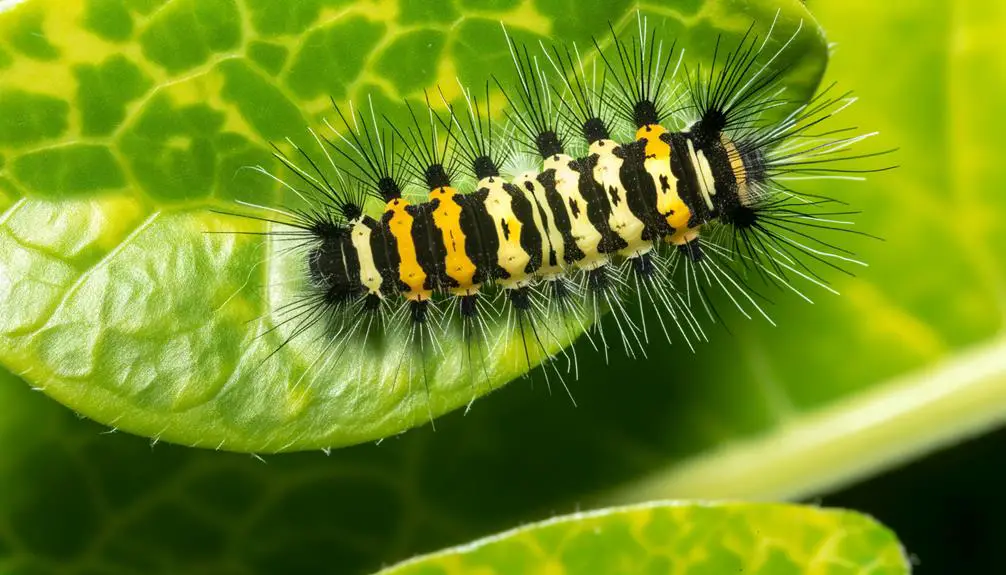
Key Takeaways
- Painted Lady butterfly caterpillars are 1.25 to 1.75 inches long with a cylindrical, segmented body.
- They feature longitudinal stripes in black, yellow, and green for camouflage.
- The caterpillars have distinctive spiky black hairs for defense.
- Tiny yellow spots are distributed along their predominantly dark body.
Size and Shape
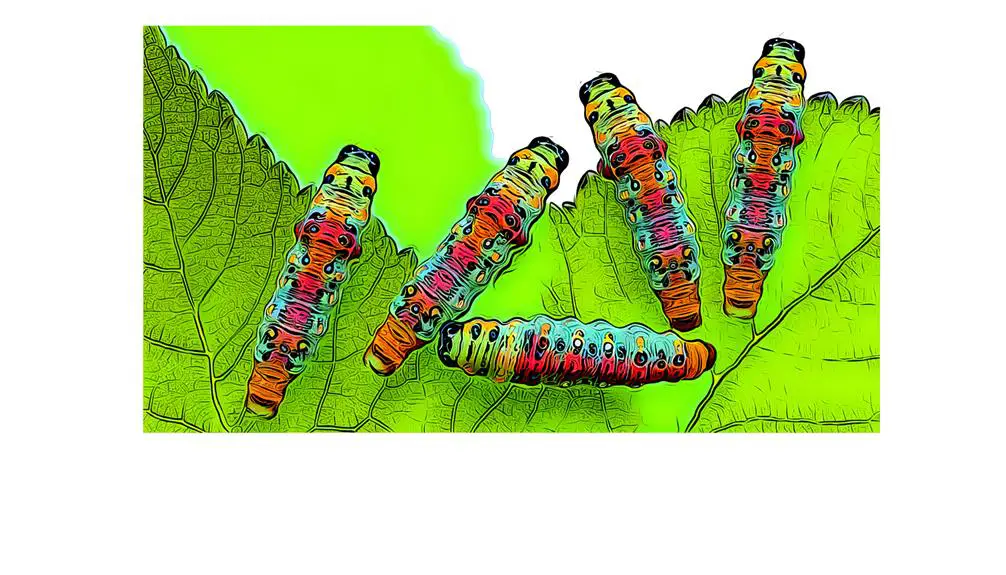
The Painted Lady butterfly caterpillar typically measures between 1.25 to 1.75 inches in length and exhibits a cylindrical body shape with distinct segmentation. Each segment features a series of minute, bristle-like structures known as setae, which serve both sensory and protective functions.
The head capsule is comparatively robust, equipped with mandibles adapted for efficient foliage consumption. Alongside the body, prolegs equipped with crochets enhance locomotion and adherence to plant surfaces.
The overall morphology includes a well-defined thoracic region, which is slightly wider than the abdominal segments, indicating its importance in movement and structural support.
This caterpillar's physical dimensions and structural adaptations are integral for its survival and mobility, aiding in its seamless progression through various larval stages.
Color Patterns
The Painted Lady butterfly caterpillars exhibit a striking array of color patterns characterized by distinctive longitudinal stripes. As they grow, these caterpillars develop spiny bristles that provide protection from predators. Once they undergo metamorphosis, their painted lady butterfly wings emerge with vibrant orange and black patterns, accented by delicate white spots. These intricate markings help them blend into their surroundings and evade potential threats.
These caterpillars are further adorned with tiny yellow spots distributed along their bodies, enhancing their unique appearance.
Additionally, the presence of spiky black hairs provides both a defensive mechanism and a critical identification feature.
Distinctive Color Stripes
Displaying a remarkable array of pigmentation, Painted Lady butterfly caterpillars exhibit distinctive color stripes that serve both protective and communicative functions. These caterpillars are adorned with alternating bands that range from black to yellow and green. The black stripes, often interspersed with narrower white or yellow bands, provide camouflage against predators by mimicking shadows and light spots on leaves. Additionally, these stripes may serve as warning signals to potential predators, indicating the caterpillar's potential toxicity.
| Color Stripe | Description |
|---|---|
| Black | Dominant, broad bands providing camouflage |
| Yellow | Narrow, intermittent stripes enhancing visual disruption |
| Green | Subtle stripes blending with foliage |
| White | Thin, intermittent lines adding to the mimicry effect |
This intricate coloration strategy underscores the adaptive evolution of Painted Lady caterpillars.
Tiny Yellow Spots
Among the intricate color patterns of Painted Lady butterfly caterpillars, tiny yellow spots play an essential role in their overall visual complexity and possible defensive mechanisms.
These minute yellow spots are interspersed along the caterpillar's body, providing a striking contrast against the mainly dark, often black, background.
Such coloration may serve as a deterrent to predators, leveraging aposematic signaling—a biological phenomenon where bright, contrasting colors warn potential threats of toxicity or unpalatability.
Additionally, these spots contribute to the caterpillar's camouflage by breaking up its outline, making it less discernible in its natural habitat.
The presence and distribution of these yellow spots are not random but rather a sophisticated adaptation, honed by evolutionary pressures to maximize survival and reproductive success.
Spiky Black Hairs
In addition to the tiny yellow spots, the Painted Lady butterfly caterpillar exhibits spiky black hairs that enhance its intricate color patterns and contribute to its defensive adaptations.
These spiky black setae, or hair-like structures, are strategically distributed along the caterpillar's body, creating a visually striking contrast against its vibrant yellow and black coloration.
The setae serve not only as a deterrent to potential predators through their intimidating appearance but also offer a tactile defense, making the caterpillar less palatable.
Moreover, these spiky hairs can cause irritation if touched, providing an extra layer of protection.
Essentially, the spiky black hairs are a critical component of the caterpillar's survival strategy, blending aesthetic complexity with functional efficacy.
Spiky Hairs
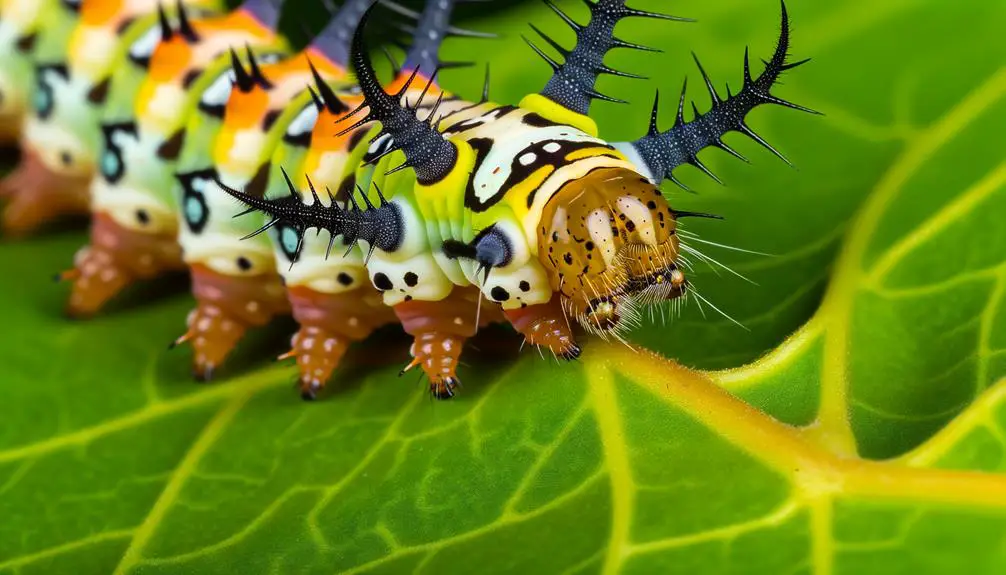
The spiky hairs of Painted Lady butterfly caterpillars serve as an effective defensive mechanism against potential predators, deterring attacks through physical discomfort.
These setae, or bristle-like structures, are a distinctive feature aiding in the identification of the caterpillar species.
Their presence not only complicates predation but also provides a means for researchers to accurately classify and study these larvae in their natural habitats.
Defensive Mechanism
Painted Lady butterfly caterpillars employ spiky hairs as an effective defensive mechanism against potential predators. These urticating setae, or barbed hairs, are strategically distributed across the caterpillar's body, providing a formidable physical barrier.
When threatened, the caterpillar raises these setae, making it difficult for predators to grasp or consume them without encountering irritation or injury. This morphological adaptation serves a dual purpose: it deters predators such as birds and small mammals while also minimizing the chances of parasitism by wasps and flies.
The effectiveness of these spiky hairs is enhanced by their rigidity and potential to break off, embedding into the attacker's skin. Consequently, the Painted Lady caterpillar guarantees its survival by leveraging this intricate, biologically-engineered defense system.
Caterpillar Identification
Identification of Painted Lady butterfly caterpillars is facilitated by the presence of distinct spiky hairs, or urticating setae, which are conspicuously arranged along their bodies. These setae are not only a key identifying feature but also serve as a defense mechanism against predators. The caterpillars exhibit a mainly black coloration interspersed with white or yellow markings, enhancing their distinctive appearance.
| Feature | Description |
|---|---|
| Body Color | Mainly black with white/yellow markings |
| Setae Arrangement | Conspicuous, spiky hairs along the entire body |
| Size | Typically 1.25 to 1.5 inches in length |
| Defensive Function | Urticating setae deter predators |
These caterpillars' unique morphology and coloration render them easily identifiable, aiding entomologists and enthusiasts in their study and observation.
Head and Mouthparts
Vital to the survival of Painted Lady butterfly caterpillars, the head and mouthparts exhibit specialized adaptations for feeding and sensory perception.
The head is equipped with six simple eyes (ocelli) arranged in a semicircle, providing limited but essential visual input. The robust mandibles, known as chewing mouthparts, are designed for efficient consumption of host plant foliage.
Additionally, maxillary palps and labial palps aid in manipulating food and enhancing gustatory perception. Sensory setae (hair-like structures) cover the head, offering tactile feedback and environmental awareness.
The combination of these features guarantees that the caterpillar can efficiently locate, identify, and consume its preferred plant matter, facilitating its growth and progression through developmental stages.
Body Segments
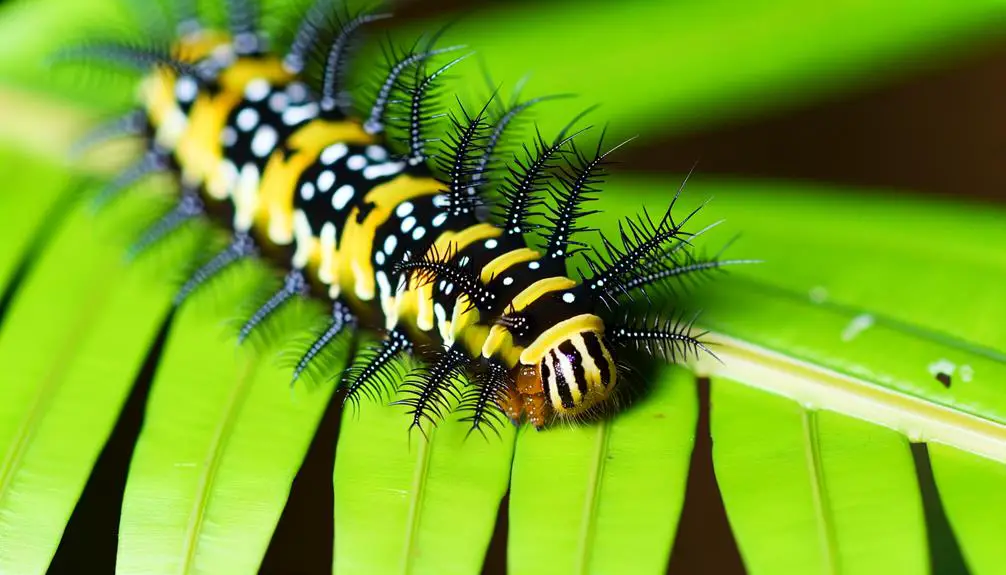
The body of a Painted Lady butterfly caterpillar is divided into distinct segments, each serving specialized functions that contribute to its overall physiology and development.
The caterpillar's anatomy consists of thirteen segments: a three-segmented thorax and a ten-segmented abdomen. The thoracic segments possess true legs covered with tiny hooks, crucial for gripping surfaces.
The abdominal segments contain prolegs equipped with crochets, aiding in locomotion and stability. Each segment is adorned with bristle-like setae, offering protection and sensory input.
Spiracles, minute respiratory openings, are located laterally on each segment, facilitating gas exchange.
This segmented body structure not only allows for efficient movement but also supports essential functions necessary for the caterpillar's growth and metamorphosis into an adult butterfly.
Movement and Behavior
Understanding the segmented anatomy of the Painted Lady butterfly caterpillar is foundational to comprehending its movement and behavior, as each segment plays a pivotal role in locomotion and interaction with the environment.
The caterpillar utilizes a coordinated wave-like motion, driven by the contraction and relaxation of its longitudinal muscles, to navigate its surroundings. Prolegs equipped with crochets on abdominal segments enhance grip on various substrates.
Behavioral observations reveal a tendency toward phototaxis, guiding these larvae toward light sources. Additionally, the caterpillar's frequent silk-spinning behavior aids in stabilizing its position on host plants.
Defensive behaviors include thrashing and regurgitation when threatened, demonstrating an intricate interplay between anatomical structure and adaptive responses to environmental stimuli.
Habitat and Location
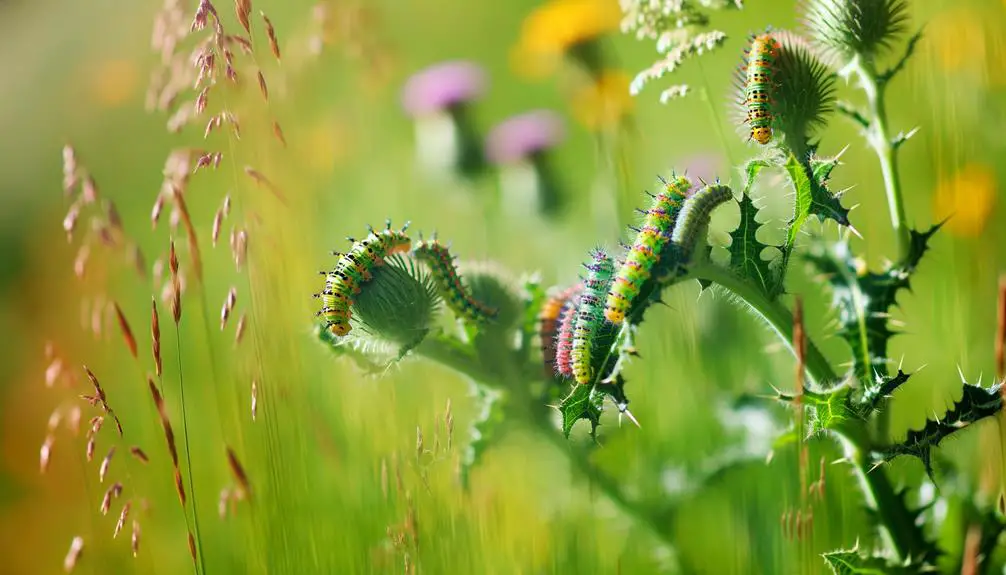
In diverse environments ranging from urban gardens to rural meadows, the Painted Lady butterfly caterpillar exhibits remarkable adaptability in selecting its habitat.
Preferring host plants such as thistles, mallows, and hollyhocks, these caterpillars thrive in temperate regions across multiple continents.
Observations reveal that the larvae favor sunlit areas with abundant vegetation, facilitating their feeding and growth.
Notably, their geographical distribution spans from North America to Europe, Asia, and even parts of Africa. This broad range is indicative of their ability to exploit various ecological niches.
The caterpillar's habitat choices are influenced by the availability of suitable host plants and climatic conditions, underscoring their resilience and versatility in diverse environmental settings.
Conclusion
The painted lady butterfly caterpillar exhibits distinct morphological characteristics, including a cylindrical body with segmented articulation and prominent spiky hairs.
Its coloration varies, typically presenting in dark shades with intricate patterns.
The caterpillar possesses specialized head and mouthparts for efficient foliage consumption.
Observations indicate a specific movement behavior, essential for habitat navigation and survival.
Found mainly in diverse habitats, these caterpillars play an important role in their ecosystems, contributing to the understanding of lepidopteran developmental stages and ecological interactions.






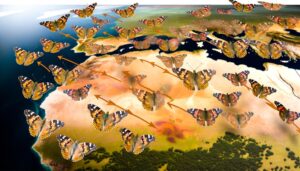
mggjxo
4liq1u
c1g7iy
Thank you a lot for providing individuals with a very pleasant chance to read critical reviews from this web site. It is usually so good plus stuffed with a great time for me and my office fellow workers to search your web site the equivalent of three times in a week to read through the new things you have got. And definitely, I am actually fascinated for the remarkable suggestions you give. Some 1 areas in this post are essentially the most suitable I’ve ever had.
https://www.zoritolerimol.com